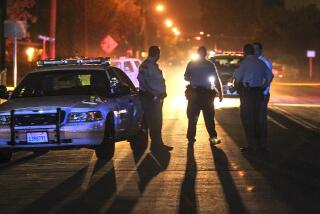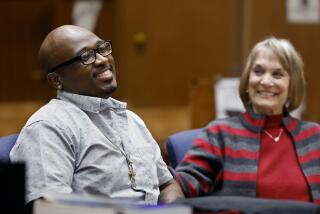Living with threats, making peace with the past
A whirring mechanical lift raised Davien Graham’s wheelchair to the witness stand in Department X on the fourth floor of the Los Angeles County courthouse in Alhambra.
Pain burned at the base of his spine.
His eyes met Jimmy Santana’s for the first time since the shooting. He thought Santana seemed much smaller sitting at the defense table than he had with the gun in his hand. In his baggy blue jail uniform, he looked like a child.
Two months earlier, on Jan. 12, 2008, Davien had been gunned down as he rode his bike in front of his church, a bystander in a gang war that had raged in Monrovia for two years.
He recognized Santana as the shooter. They had gone to school together. Still, Davien was afraid to identify him to police. He had been raised by a father and an uncle who were Crips, who taught him that victims don’t snitch.
But Davien had shunned gangs for a Christian life, and believed lying was wrong. So when asked by detectives, he had circled Santana’s photo in a lineup of mug shots.
Now he was being asked to set aside fears of retaliation and testify.
Staring at Santana, Davien said the first thing he remembered telling his family after the shooting was, “I forgive the person who did this to me.”
Santana stared back, appearing unmoved.
Sitting in his wheelchair, legs paralyzed, Davien could see Santana’s mother in the gallery, a small woman with a strained face. A group of young people lounged behind her.
Maybe they were in the car with Jimmy that day.
Police never caught the getaway driver.
The prosecutor asked a question, addressing Davien as John Doe, an effort to protect his identity. It didn’t matter. Everyone involved in the case knew Davien.
“Do you see the man who shot you here in court today?”
“On the right side of the courtroom, and he’s wearing a blue uniform,” Davien said.
That was all the judge needed to hear. He ordered Santana to stand trial. Davien was free to go.
But he didn’t feel free.
Sheriff’s investigators said he wasn’t at risk, and his family didn’t need protection. But he didn’t trust the Sheriff’s Department. The sheriff had sent a task force to Monrovia to stop the gang violence. They dropped warnings at gangsters’ homes.
His uncle got one. So did Davien.
That upset him. Unlike his uncle, Davien had never joined a gang.
They must think I’m a gangster who got shot as payback.
As Davien left court, the judge ordered two deputies to escort him to the parking lot, just in case.
***
Davien knew his biggest hurdle lay ahead: testifying at Santana’s trial.
As the case dragged on, Davien felt as if he was doing time, waiting. He began to believe that his aunt and uncle, Joni and Terry Alford, resented caring for him, especially when he bumped into their furniture or urinated in his shabby wheelchair.
They didn’t seem to fear for his safety. Sometimes when they ran errands, they would leave him alone in the car, where he felt trapped and exposed.
Davien wanted to put the trial behind him. He wanted out of Monrovia. He decided the best way out was to finish high school and make it to college.
In September, he returned to Monrovia High; back among friends, he thrived. He almost forgot about the trial. Then one day some guys drove by his house, shouting threats. It wasn’t clear if the message was meant for Davien or for his uncle.
Some time later, Davien was called to the principal’s office. Sheriff’s deputies were waiting. They told him they had intercepted a threatening message in gang code at the county jail. He apparently was being targeted.
We’re taking you home to grab some things, the deputies said. You can stay in school, but not with your family. You’re being relocated.
Back at the house, his aunt watched him pack. Deputies could not say where he was going, or for how long.
“It’s messed up,” Davien said, trembling. “Not only did he take my legs away from me, now he’s trying to take my whole life.”
Deputies took Davien to stay with a teacher the officers knew.
Davien felt safer. But he still worried, especially about his brothers at home. One of them had started working at Calvary Grace, the church where Davien was shot.
::
Over the next three years, as the sheriff’s task force tamped down the gang war, Davien’s case passed to a new public defender, a new prosecutor and six different judges.
Davien graduated from high school and moved from Monrovia to attend college in Fullerton. He learned to get around in his wheelchair, and had more surgeries than he could remember to deal with the bullet fragments inside his body.
One day last fall, as he was preparing for exams, Davien arrived at his apartment to find waiting sheriff’s deputies and a detective he had grown to trust, Scott Schulze. The trial was starting Jan. 26, 2012. They handed him a subpoena. He was startled and upset.
He had agreed to testify. Why were they acting as if they had to force him, surprising him at his apartment with his friends?
Davien called the new prosecutor. He didn’t trust her, so he recorded the call. He asked why she hadn’t come to see him herself and why she sent deputies when she knew he had agreed to show up.
She didn’t sound apologetic, he thought.
He hung up feeling as though he was heading to court without anyone on his side.
::
Davien could feel jurors’ eyes crawling over his face. He stared ahead, focusing on the prosecutor, just as Schulze had recommended.
Davien, by then 20, shifted in his wheelchair on the stand, looking down at the gallery. He recognized Santana’s mother. She and another son testified that Santana was home with them at the time of the shooting. It was their word against Davien’s.
No one from Davien’s family was there. He didn’t tell them about the trial because he didn’t want to put them at risk if gang members showed up.
He tried to clear his throat; his mouth was dry. In a court system that was handling more than 1,800 attempted murder cases, 600 of them gang-related, he felt lost.
He hoped jurors could read him, the way parents read a child. Jurors needed to see that he was no gangster. He just happened to be young and black and in the wrong place.
Surely the lone black juror, a woman staring at him from the front row, would understand.
Santana, 23, sat 15 feet away, slouching into a baggy dress shirt.
The prosecutor asked Davien to demonstrate how his attacker pointed the gun.
Davien extended his willowy arms, clasping his hands in the shape of a pistol. He winced. His back ached every time he bent his 6-foot-4-inch frame to the microphone.
“Where was it being pointed?” the prosecutor asked.
“At my face.”
He could feel sweat spreading under his arms, wilting the new button-down shirt he had bought at Target for the trial.
“Did you see anyone in the car?” she asked.
“I saw a driver and a passenger,” Davien said, without looking at Santana.
“Did you know who said, ‘Hey, fool’?”
“The passenger,” he said.
“Did you get a look at the passenger?”
“Yes, ma’am.”
Now Davien glanced at Santana. The accused was biting his shadow of a mustache.
“Did you see his face?” the prosecutor asked.
“Yes, ma’am.”
“Can you look around the court and see if the person is here?”
Davien did not hesitate.
“Yes, ma’am,” Davien said. “He is sitting next to his lawyer in a collared shirt.”
“How confident were you that he was the person?”
“One hundred percent.”
Not long afterward, Santana’s public defender stood. Davien had once imagined himself looking just like that lawyer: a black man standing tall in an elegant suit.
What was the name of your uncle’s former gang? the lawyer asked.
Davien frowned. “I don’t recall.”
“You don’t recall what gang?”
The prosecutor objected. The judge overruled her. Davien had to answer the question.
“He was a Crip,” Davien said.
Jurors shifted in their seats. Davien feared they were souring on him. They didn’t know how hard he had tried to live right.
They think I got shot for a reason.
::
At 3:50 p.m. on Feb. 2, after six hours of deliberation, a buzzer sounded signaling a verdict.
The bailiff brought Santana into the courtroom. His mother bowed her head and grasped the hand of her other son, praying in a whisper of Spanish: “Let it be just.”
For added security, four more bailiffs slipped into the courtroom.
As the clerk read the verdict, Santana shook his head.
Guilty on all counts, including willful, deliberate and premeditated attempted murder.
Santana sobbed, curling into himself. In the gallery, his mother was weeping.
Jurors filed out, eyes darting, avoiding the Santanas and searching for the polite young man in the wheelchair whom they would later say they believed from the moment he took the stand.
But Davien had gone back to school.
He would later send a statement for the prosecutor to read to Santana at his sentencing in June.
The shooting broke him, Davien wrote. But he managed to recover and start a new life.
“I hope that you can become a better person during this whole experience,” he wrote to Santana. “Life does not end here for you. You can still do good to the world.”
Santana and his family declined to be interviewed for this article. He was sentenced to 40 years to life.
***
A month and a half after the trial, on March 17, 2012, Davien was surrounded by a crowd at his apartment. It was his birthday. He had fulfilled his childhood goal: survive to age 21.
Davien belted out a rap song he had composed.
“What do you see when you look in the mirror? Does it fade away or all get clearer?”
Davien’s father, Steven “Steve-O” Graham, was in the crowd. The former Crip had straightened out and started a handyman business.
Davien made peace with him and his mother — but as friends, not as parents. He had been his own parent for a long time.
Davien had a new goal. He was finishing his third year of college, planning to graduate with a degree in video production.
School can take me places that walking can’t.
He has a five-year plan, which includes self-producing two rap albums from his mix tapes: “Musical Chair” and “Ramps and Elevators.” He wants to produce a clothing line featuring a stylized handicapped logo, an after-school program for at-risk youth and a screenplay titled “Where There’s Wheels, There’s a Way.”
At the party, his girlfriend, a fellow student, presented a marble sheet cake decorated with his planned album cover: a photo of Davien in his wheelchair.
“It’s not every day a young man turns 21,” his father said. “You’re grown for the rest of your life — don’t turn back.”
He handed Davien a flute of pink champagne. Davien sipped slowly. Leaning forward to blow out his candles, he made a wish.
molly.hennessy-fiske@latimes.com
Second of two parts. Previous: A gunshot victim wrestles with his fears
More to Read
Start your day right
Sign up for Essential California for news, features and recommendations from the L.A. Times and beyond in your inbox six days a week.
You may occasionally receive promotional content from the Los Angeles Times.






